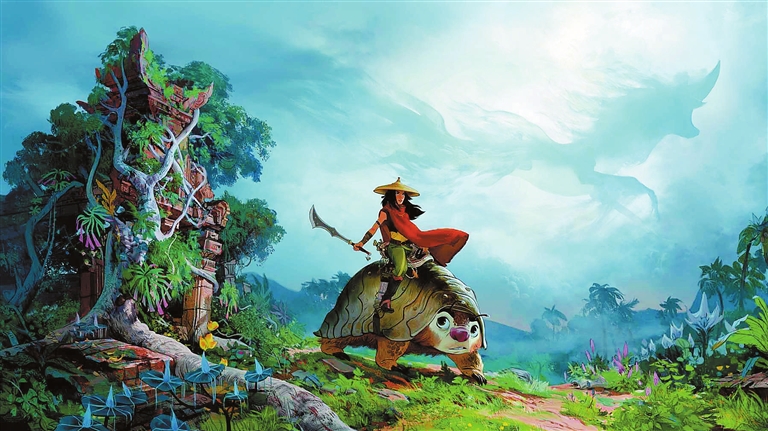
Lin Lin linlinasa@163.com MUCH was expected from Disney’s latest animated feature “Raya and the Last Dragon.” It has created the studio’s first Southeast Asian princess—a brave female warrior, and a fantasy world inspired by Southeast Asian cultures. However, despite such an unprecedented cultural background in the studio’s history, the movie is still a formulaic adventure fantasy in terms of both story and character development. The way the movie builds its plots fails to present the cultures in an in-depth way, and thus has reduced the sophisticatedly designed fantasy land to a mere background of the heroine’s adventures. The movie is set in Kumandra, an imagined land consisting of five tribes named after the parts of a dragon — Heart, Tail, Talon, Spine and Fang. The tribes used to live in harmony under the blessing of dragons. However, 500 years ago, in order to protect humans from the Druuns — purple-clouded monsters that turn creatures to stones upon touch, all dragons died except one named Sisu. In the war against the Druuns, a magical orb was created by the dragons and left to human beings under the guardianship of the Land of Heart. The movie’s heroine, Raya, is the daughter of Chief Benja of the Land of Heart. To reunite the broken tribes of Kumandra, Benja invites the other four tribes to a dinner. The gathering, however, ends up with the orb being broken into five pieces. Each tribe takes one piece away. Kumandra is once again attacked by the Druuns, and Benja is also turned into a stone statue. To save the world and her father, Raya embarks on a quest to find the last dragon and retrieve the orb pieces. Through an opening monologue by Raya, we know from the beginning of the movie the different features of the five tribes. Also, a map of Kumandra shows up repeatedly, allowing us to predict the route of Raya’s quest. All of these take away much freshness and novelty that the audience may experience as the world gets gradually unveiled in Raya’s adventure. Such lack of suspension may be compensated if the adventure unfolds with more twists and turns. However, the quest is infused with a sense of deja vu that we experience while watching a Hollywood adventure movie. Almost all the problems Raya faces in her journey are addressed by combating. Although the action scenes are grandly presented, too many of them just seem to be one-note. One way to address such a problem is to build the plots around the cultural background. The movie’s artists have done detailed research into the Southeast Asian cultures with field trips to Southeast Asian countries and created designs inspired by such cultures in terms of landscape, architecture, costume, combat styles, food, and many others. Also, each tribe is attributed with distinctive cultures and features. However, the plots are detached from the specific cultural settings. The same story will still make sense if it is set in a European cultural background. Unlike “Coco,” Pixar’s 2017 movie which has not only invited the audience into a vivacious afterlife underworld inspired by Mexican folklores, but also allowed such cultural background to carry the story deep into how Mexican culture embraces death — the theme of the movie, “Raya and the Last Dragon” still adopts an outsider’s point of view and presents the fantasy world in a touristy way. Another problem of the movie is that Raya’s character has not much development and is unable to invite sympathy from the audience. The heroine is portrayed as a brave, independent female warrior who has trust issues but learns at the end of the movie the value of trust. However, this character arc is not compelling enough. The princess gets her trust issues at the beginning of the story when she is betrayed by Namaari, the princess of the land of Fang. However, such issues are not tested over the course of her journey. As a result, the change comes more like an epiphany than a convincing internal development. Of course, the movie has much to offer with the wonderful world it has built, and the adorable characters such as the last dragon Sisu, a funny teenager character voiced by Awkwafina and a badass orphaned toddler adopted by Ongis, a group of half-monkey, half-catfish creatures. But for a studio that has created so many ingenious stories for audience around the world, these are just not enough. The movie is now being screened in Shenzhen. | 
